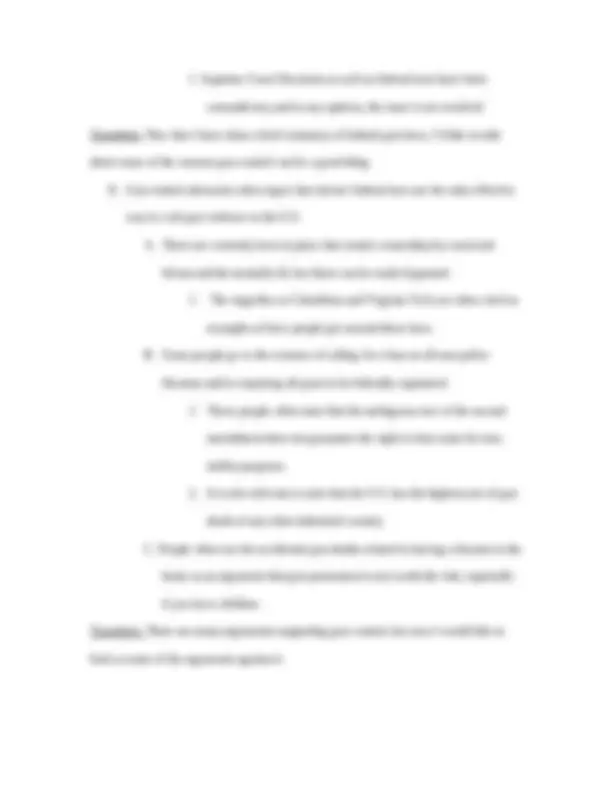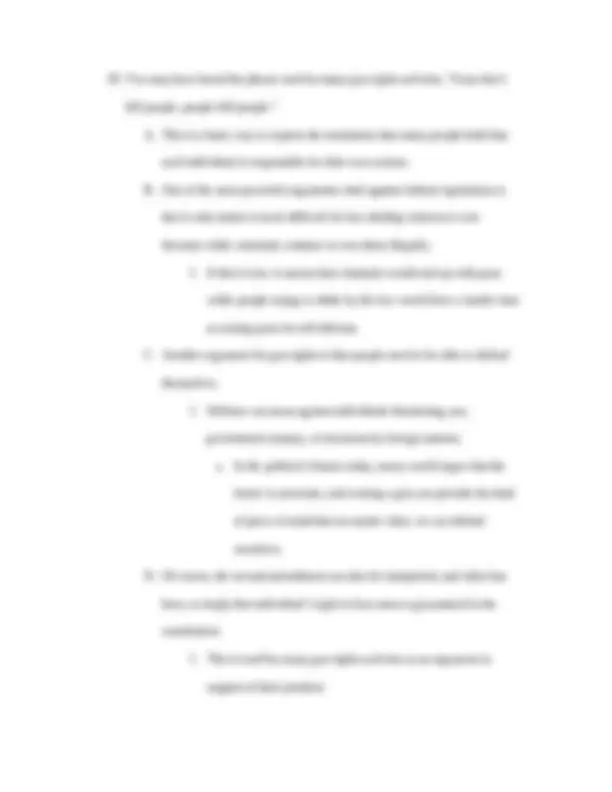





Study with the several resources on Docsity

Earn points by helping other students or get them with a premium plan


Prepare for your exams
Study with the several resources on Docsity

Earn points to download
Earn points by helping other students or get them with a premium plan
Community
Ask the community for help and clear up your study doubts
Discover the best universities in your country according to Docsity users
Free resources
Download our free guides on studying techniques, anxiety management strategies, and thesis advice from Docsity tutors
A speech script for a presentation on federal gun control laws in the u.s. The speaker summarizes major gun control legislation and explores arguments for and against these laws. The presentation concludes with an invitation to discuss the issue.
Typology: Papers
1 / 7

This page cannot be seen from the preview
Don't miss anything!




Sarah Peters Com 115- October 20th, 2008 Federal Gun Control Laws Topic: Federal Gun Control General Purpose: To Invite Specific Purpose: To invite the audience to discuss the pros and cons of federal gun control legislation in the U.S. and the consequences and benefits of such laws. Thesis Statement: I will summarize federal gun control laws and discuss the arguments used in support of these laws and against them, and then I will open the floor to discussion. Introduction I. (Attention Getter) “A well regulated Militia, being necessary to the security of a free State, the right of the people to keep and bear Arms, shall not be infringed.” This is the text of the second amendment to the United States Constitution, found on the Charters of Freedom website, last accessed November 10th, 2008, www.archives.gov. II. (Introduce Topic) The right to bear arms has been a hot topic in the United States for as long as we have been a country. III. (Audience Adaptation) Perhaps some of you are hunters, or own a gun for self defense, while others may worry about crime rates and deaths from handguns.
IV. (Establish Credibility) I recently became more interested in this topic when I had a discussion with my mom about federal gun control and decided to do some research for myself. V. (Preview) Today I would like to summarize some of the major federal gun control legislation and explore both sides of this debate, and then I will open the floor to discussion about this issue. Body I. Since the second Amendment was ratified in 1791, there have only been a handful of major federal decisions regarding the right to bear arms. A. As summarized in an article titled “U.S. Gun Laws: A History” found on the National Public Radio website, www.npr.org, last updated June 26th, 2008; the first major Supreme Court decision was in 1939, when it upheld a federal ban on sawed off shotguns.
III. You may have heard the phrase used by many gun rights activists, “Guns don’t kill people, people kill people.” A. This is a basic way to express the sentiments that many people hold that each individual is responsible for their own actions. B. One of the most powerful arguments cited against federal regulations is that it only makes it more difficult for law-abiding citizens to own firearms while criminals continue to own them illegally.
Work Cited Alito, Samuel. “District of Columbia v. Heller, Majority Opinion.” Supreme Court of the United States. 26 June, 2008. http://www.supremecourtus.gov/opinions/07pdf/07- 290.pdf Altman, Alex. “The Future of Gun Control.” Time.com. 26 June, 2008. http://www.time.com/time/nation/article/0,8599,1818325,00.html. “Restoring America’s Freedom” FDRS. 10 Nov., 2008. http://www.fdrs.org/quotes_on_gun_control.html “Second Amendment to the United States Constitution.” Charters of Freedom. 10 Nov.,